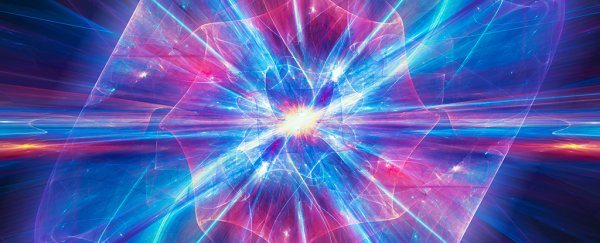The results of a new comparison between hydrogen's spectral fingerprints and those of its mirror twin are in, and the news is frustrating – they're a match right down to just two parts per trillion.
If they turned out to be even a tiny bit different, physicists might at last have a way to explain why our Universe contains more matter than antimatter. But even though the results are still exciting, one of science's biggest mysteries remains unsolved.
The discovery itself is truly record-breaking – roughly 15,000 atoms of antihydrogen had their light waves measured in an unprecedented analysis of their spectral properties.
Just making all of those antihydrogen atoms is itself quite a feat of technology, let alone containing them and measuring the frequency of their light waves.
It's been about 18 months since physicists at CERN first successfully measured the spectral fingerprints of antihydrogen, and about nine months since they followed up on their research by measuring the light emitted from just under 200 atoms of antimatter.
In both cases, physicists measured the frequency of light produced when an antihydrogen's positron jumped back and forth between two positions.
As far as they could tell, it was the same as the frequency of light produced by a hydrogen electron moving between the same positions.
This latest effort represents a significant leap forward in technology, and improves the precision of that measurement from an error of four parts per 10,000 down to just two per trillion.
We can be more confident than ever that flipping the charge on mirror-Universe hydrogen doesn't change how it emits light.
This is one of those good-news, bad-news things.
First, the good news.
The find helps refine where symmetry breaks down in particle physics by two orders of magnitude.
Symmetry is a big deal when it comes to understanding why our Universe looks the way it does, especially when we look at things like the charge, space, and time of a particle.
Imagine a different Universe where all of these things were reversed, such as if negatives were made positive, directions were flipped, and time reversed. Would we still end up with a Universe that resembles the one we live in today?
Past experiments have shown there are some tiny differences in how forces work on a particle scale if we only flip the charges or change orientations.
But a completely antimatter 'mirror' Universe where time runs backwards should look just like ours, at least where the laws of physics are concerned.
So setting new limits of what we called charge-parity-time (CPT) invariance when we flip hydrogen to antihydrogen is useful stuff if you're a physicist studying particle symmetry.
Now, the bad news. Our Universe started out with equal amounts of matter and antimatter in the same space.
Theoretically, having these symmetrical partners next to each other should demand that they cancel out, which would have left nothing to build planets, suns, and humans.
Should there have been a tiny difference between matter and antimatter – if that perfect combination of CPT symmetry was violated in the smallest way – then we might have a way to explain why we now have plenty of leftover matter to build a Universe of galaxies.
But, if there is such a difference, this experiment didn't see one. That means it's smaller than two parts per trillion, or we're barking up the wrong tree.
One other potential avenue worth exploring involves the ghostly neutrino particle, which is thought to be its own antiparticle.
A number of large scale experiments are currently underway to solve that one.
If it is antimatter-matter in one, factors that persuade neutrinos to take one form over the other might help explain the prevalence of matter in our Universe.
And if they come up empty handed? We just might need to wait a while longer before learning why we exist.
This research was published in Nature.
